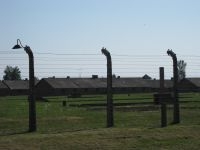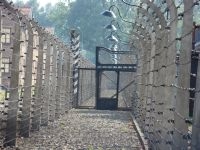Introduction to Auschwitz
The first camps
Nazi Germany, under Adolf Hitler, maintained concentration camps throughout the territories they controlled. The first Nazi concentration camps were greatly expanded in Germany after the Reichstag fire in 1933, and were intended to hold political prisoners and opponents of the regime. They grew rapidly through the 1930s as political opponents and many other groups of people were incarcerated without trial or judicial process. Holocaust scholars draw a distinction between concentration camps and extermination camps, which were camps established for the sole purpose of carrying out the extermination of the Jews of Europe—the Final Solution, Poles – the Lebensraum, Gypsies and other nations.
Extermination camps included: Belzec, Majdanek, Sobibor, Treblinka and Auschwitz -Birkenau.
The mechanism
The Nazis were one of a number of political parties in Germany with paramilitary organizations at its disposal, the Schutzstaffel (SS) and Sturmabteilung (SA), both of which perpetrated surprise attacks on the offices and members of other parties throughout the 1920s. After its failure to win the 1932 election, the Nazi leaders decided that they would have to use other means to gain power. In addition to an increased use of violence, aimed at disrupting and intimidating their opponents, the Nazis set up concentration centres, usually under the auspices of local authorities that they controlled. In these camps were held, tortured and killed opponents such as Communists and journalists. Following formation of a coalition government between the National Socialist (Nazi) NSDAP party and the German Nationalist People's party and, ultimately, establishment of the Nazi dictatorship, the early concentration camps (usually basements and storehouses) were consolidated into large scale, centrally run camps outside the cities and more removed from the public eye. In 1938, the SS began to use the camps as a source of forced labour for profit-making ventures. Many German companies used forced labourers from them, especially during the war.
By 1939; 6 large concentration camps had been established: Dachau (1933), Sachsenhausen (1936), Buchenwald (1937), Flossenburg (1938), Mauthausen (1939), Ravensbruck (1939).
Additionally, historians speculate that the Nazi regime used abandoned castles and similar existing structures to lock up the undesirable elements of society, such as handicapped, mentally ill etc. There, they were starved or gassed to death with diesel engine exhaust.
'The Final Solution' was therefore initially tested on German citizens in Action T4, the Nazi program of racial hygiene. During the II WW concentration camps for “undesirables” spread throughout Europe. New camps were created near centers of dense “undesirable” populations, often focusing on areas with large communities of Jews, Polish intelligentsia, Communists or Gypsies. Since millions of Jews lived in pre-war Poland, most camps were located in the area of General Government in occupied Poland. It allowed the Nazis to transport the German Jews outside of the German main territory.


KL Birkenau

Auschwitz I

KL Auschwitz

KL Auschwitz Birkenau - the biggest cemetery without graves




